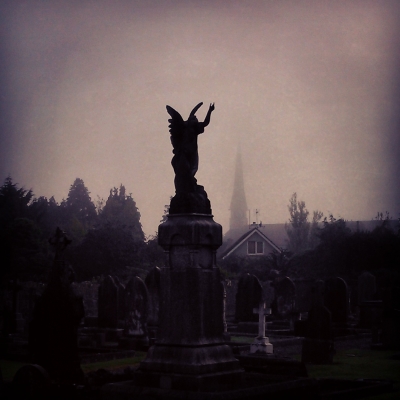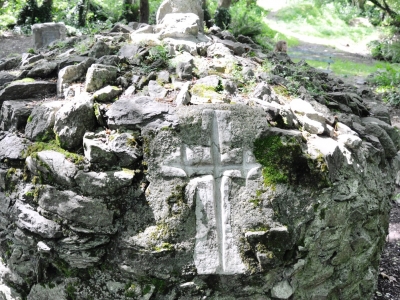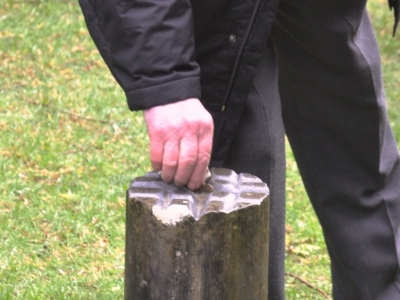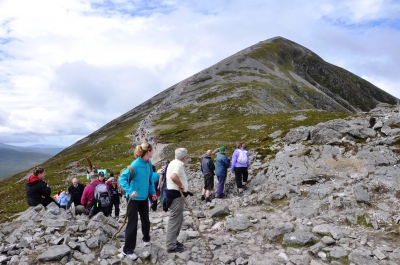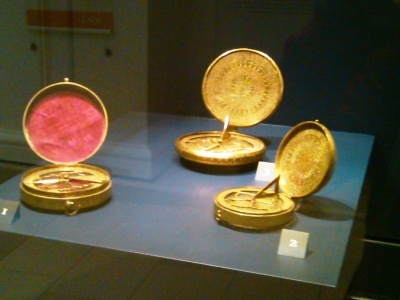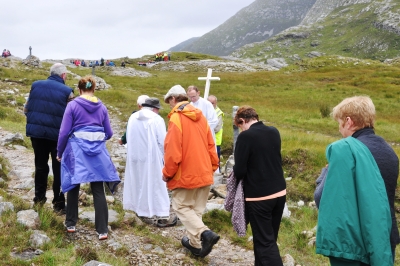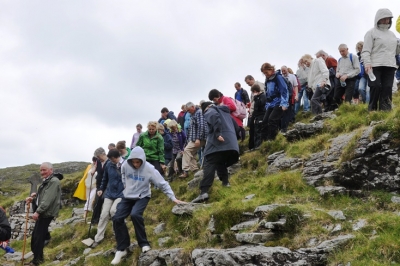-
Inscribing Crosses
The imprinting of crosses is a practice that is found at many holy wells. It is a simple, yet lasting action that seems to speak to the heart of these pilgrimages. The engraving of crosses at particular spots is an established part of doing ‘the rounds’ in some cases, as is found at St Gobanit’s Well in Ballyvourney or ‘the City‘ near Rathmore. These simple features are tangible forms of continuity, as successive pilgrims, over time, have worn the shape into the hard stone. However, there can also be newer crosses found indicating that personal variations are leading to development of supplementary practices.
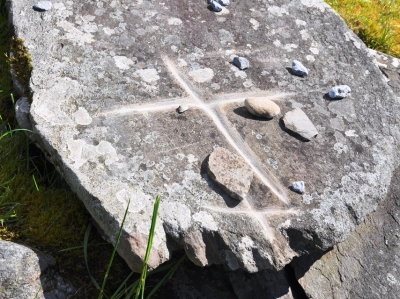
A single cross is worn into the large capstone on St Gobnait’s Grave; the grave is a station on the turas which is circled several times and stopped at for prayer.
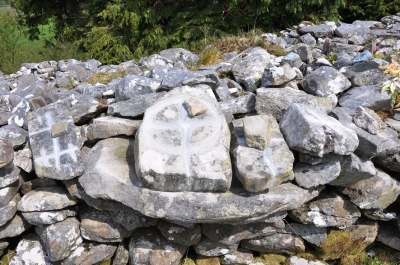
Crosses are imprinted into four rocks at the Eastern prayer Station in ‘the City’ as part of the rounds.
The crosses are manifestations of faith in the places and the intercessory power of the patron saints. Each cross was forged as pilgrims performed these local pilgrimages for particular intentions: cures and hopes, dreams and problems, worship and thanks. The action of making the cross, which wears down further in the stone each time, is intimately linked the motivations of each pilgrim. The gap that is the cross – the distance from the depth of the imprints to the rock surface – is not an eroded void, but a space willed with supplications, prayers and beliefs. These intentions and beliefs remain embed in these sites as the physical geography, cultural tradition and spiritual practices combine in these simple forms.
-
Going on Pilgrimage – Book of Lismore
Going on pilgrimage without a change of heart brings little reward from God. For it is by practising virtue and not by mere motion of the feet that we are brought to heaven. – Book of Lismore
This quote has been placed at the beginning of Tóchar Phádraig at Ballintubber Abbey establishing a meaning of pilgrimage which draws on the early Irish Church. I have referenced this quote in numerous public presentations and it is a sort of definition of pilgrimage that really resonates with people. It nicely combines the idea of pilgrimage as a physical journey and a spiritual/emotional (or meta-physical) journey. As I have previously discussed, pilgrimage involves a number of characteristics that distinguish it from other types of travel and this quote captures that idea well. Pilgrimage is a type of meaningful movement, a journey or undertaking of significance, one that takes shape in doing, feeling and believing.
-
Prayers, Waves, Reverberations: An audio engagement with phenomenal pilgrimage
My second paper at the RGS-IBG Annual Conference 2014 is part of the ‘Postgraduate Snapshots: Engagements in Social and Cultural Geography‘ session, which explores the different ways in which postgraduates are (co) producing social and cultural geographies through their research, collaborations, methods and encounters. Each participant presents a ‘snapshot’ (an image, object, media clip etc) of their research in a creative and interactive way.
Prayers, Waves, Reverberations: An audio engagement with phenomenal pilgrimage
Using an audio clip of pilgrims praying in St Patrick’s Basilica on Lough Derg in northwest Ireland, I consider how the aural and acoustic induces, enhances and disorientates the phenomenal and spiritual experience of being a pilgrim. My research, informed by the mobilities field and nonrepresentational approaches, explores pilgrimage practices in contemporary Ireland. An audio recording taken during the Night Vigil on Lough Derg, where pilgrims stay awake for 24hrs fasting and praying barefoot on a lake island, captures a portion of the atmospheric and sensuous as they unfold. Drawing on my ethnographic fieldwork, I present the sounds and audio waves, which reverberate with meaning and experience, as being simultaneously created and received, embodied and asomatous, ethereal and material. Speculation on conceptual and practical approaches to and challenges for the use of audio are also offered.My presentation centres on a continual playing of the audio clip, to generate suitable atmospherics, as I verbally offer context, comment and speculation. In foreground the use of audio, I shall build on the increasing role for audio, sound and the sonic in social and cultural geography.
-
Ireland’s Holy Mountain: symbiosis, co-existence and tensions on Croagh Patrick
My first paper at the RGS-IBG Annual Conference 2014 is within the session Sacred Space, Pilgrimage, and Tourism which looks at sacred space through the areas of the sacred, such as pilgrimage/theology/spirituality/belief systems, and the more secular, incuding tourism/leisure/promotion/visitor behaviour. My contribution is on Croagh Patrick.
‘Ireland’s Holy Mountain’: symbiosis, co-existence and tensions on Croagh PatrickIn this paper, I examine Croagh Patrick, Ireland as a space that is simultaneously sacred and secular, political and recreational and of the past and present. This mountain in County Mayo, which has been the location of religious-spiritual activity for millennia, serves as one of the most prominent pilgrimages in Ireland, as well as being a venue for hill-walkers and tourists. Recent engagements with sacred spaces, being influenced by phenomenological and non-representational approaches, have conceived of them as being performed or in continual a state of becoming. Using my fieldwork experiences on Croagh Patrick, I explore how the different practices on the mountain create it as a space of devotion, leisure, protest and charity in ways which can be complementary, synchronous and frictional. By focusing on the embodied spatial practices, consideration is given to how these interactions form and forge meanings, places and participants.Spiritual Directions
These beautiful brass compasses on display in the Victoria and Albert Museum reminded me of the importance of direction within Islamic Prayer. These compasses would have been used to establish the direction of the Ka’bah in Mecca, or the Qiblah. The cases contain engravings of the coordinates for Mecca from different cities in the Islamic world.
This feature of Islamic prayer is a very clear example of a spiritual or religious geography. In this case, there is a very literal connection between location and faith. These compasses hint at the efforts that individual Muslims most undertake to perform their faith. The requirement of regular prayer necessitates that each person must have an awareness of directions in their daily lives. As a geographer, this rich connection between belief and location is fascinating.
Máméan Pilgrimage
Máméan is a mountain pass pilgrimage located in Galway between Connemara and Joyce Country. The traditional pilgrimage is practiced on the first Sunday in August, linking back to the Celtic harvest feast of Lughnasa. Pilgrims walked, sometimes barefoot, from either side of the Maum Turk Mountains to the site. St Patrick’s Bed, two holy wells and a number of leachtana are the focus of older customs, while more recently a revival of the pilgrimage has involved the performance of the Stations of the Cross and the saying of mass.
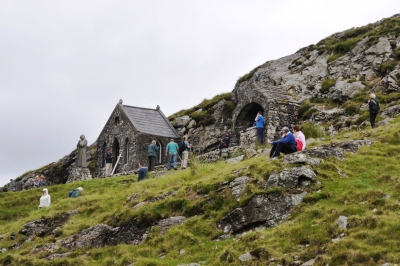
The more recent additions of the small chapel and the statue of St Patrick stand next to the grotto containing St Patrick’s Bed.
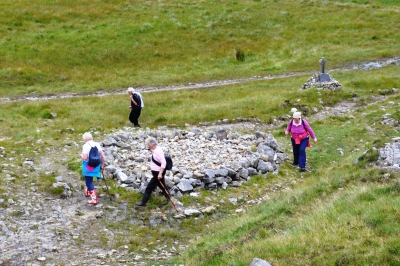
Pilgrims circling on of the leacht at the site. They throw a stone into the centre after completing their rotations.
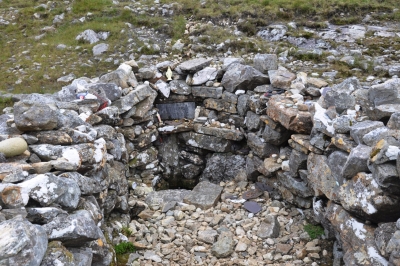
Tobar Phadraig or St Patrick’s Well, one of two wells on the site. It is rounded as part of the pattern.
These photos were taken during the 2012 pilgrimage.
An on-going prayer
Rotating and kneeling, flow and pause, the intentions of the pilgrims immerse and emanate in this prayerful event: performing the Penitential Beds on Lough Derg.* The movements, gestures and bare feet call out in silence, a scene of activity, harmony and stillness.
One of the aspects I find most appealing are the patterns of movements. Rotations around and within each bed continually being performed and punctuated by pauses. This beautiful, unfolding scene is an ongoing prayer. A prayer that continues every day throughout the summer.
A certain reassurance radiates from these events, reminding me that all through the pilgrimage season (1st June-15th Aug) there are pilgrims praying on Lough Derg. Praying for personal intentions but also more universal themes of peace, well-being and hope. They are praying for me, for you, for us all. While I go about my daily life there are people praying the beds, as I eat they are fasting and every night as I go to bed, I think of those pilgrims preparing to undertake their Vigil. On a small lake island in Donegal, while we rest, they keep Vigil.
* This short video clip of pilgrims on the beds, taken from the roof of the male dorms and enhanced through a Vimeo filter, captures some of the unique character of St Patrick’s Purgatory.
Lines
Lines are traced and followed, made and extended, grooved and lived. I’m concerned with the lines of the pilgrim path. Using the ‘Pencil Sketch’ function on MS Powerpoint I altered some fieldwork photos taken while walking Tóchar Phádraig as part of different groups over the past few years as a way of exploring the role of lines. Starting with the literal lines of the images rendered as drawings, I wish to explore the others lines and meanings present.
Robert Stoddard, in his 1987 article Pilgrimages Along Sacred Paths, explored the geography of sacred space as points, lines, or areas, with the lines category referring to the routes of travel of activities associated with religious motives. This classification draws attention to the line itself, that is the pilgrim path in this cases, as having significance, rather than being a mere route to a sacred site (spot). Elsewhere, the anthropologist Tim Ingold, in his book Lines: A Brief History, explores the potential of the line as movement, through the concept of wayfaring. The line is a pathway, it is movement, it is the means through a person engages with the surrounding environment.
Through a few (geo) poetic stanzas I trace some thoughts on lines in this pilgrimage. I wonder where they will lead?
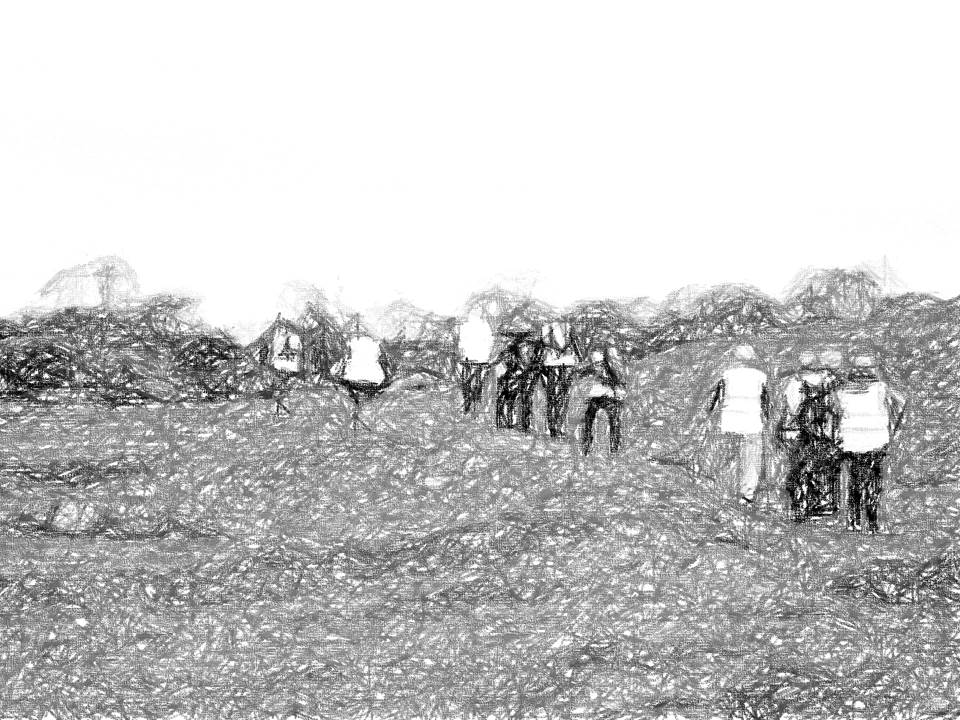
Pilgrims:
A row setting out
Near departure, pace emerging
Movements and motions linking each person to the next
Each person is the line
Leading and following, a common rhythm, an alignment
Pilgrims as line
Path:
The path is active
It has been walked and will be walked
Stretching across the boggy terrain
A trackway towards the Reek,
but also approaching other places
Lines roaming out, in and beyond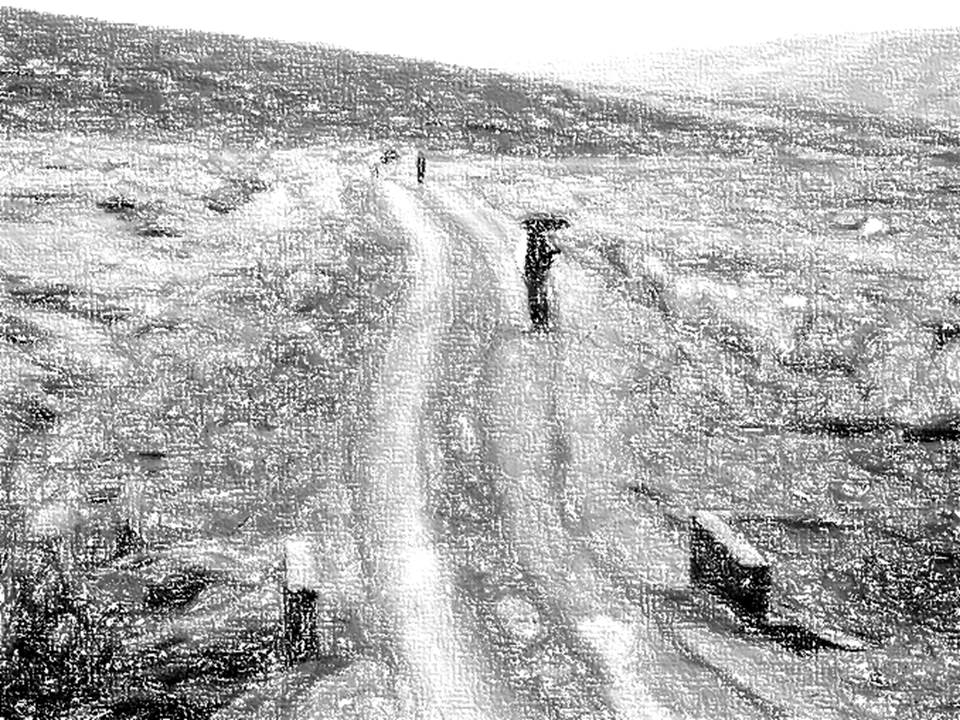
Landscape:
Sweeping, reaching, gliding
The path, the land, the pilgrims are spaced
Each line mingles and flows
The path is landscape, landscape is pilgrim, pilgrim is path
All are linesWikipedia: Creating as well as consuming online
A recent Wiki workshop for Geographers organised by WikiMedia UK and the RGS-IBG, demonstrated the positive role that people can play in both disseminating knowledge and contributing to the online resources. The workshop outlined the ideas central to Wikipedia, the operating principles and ways of creating and editing content. Beyond the particulars, I took three main points away from the day, which I think worth sharing.
1. Wikipedia is an important tool. It is much maligned in the academy, but this approach puts the emphasis on the wrong aspect: the tool is not the issue, how you use it is. It should be appreciated for what it can do and not dismissed for what it can’t. Wikipedia is a gateway or a starting point for general information, summaries and signposting. If someone misuses it in an academic context, this is not Wikipedia’s fault, it is more likely a case of poor online literacy and/or bad judgement. The session helped me form a renewed appreciation for Wikipedia.
2. We have a role and even a duty to participate. We all have knowledges, skills and access that are not available to the others and these can be used to benefit discussions, debates and understandings. This is especially true for those in university settings. My own interest saw me gravitating towards areas such as Social and Cultural Geography or Research Methods where I found articles I could contribute to. Anyone with an area of expertise can contribute to these sections. The content is decided by those who write it, but in the case of Wikipedia that editor/author can, and should be, you.
3. It is easy. The editing and creating of content is very accessible. With a little knowledge, you can do a lot. The singular common observation from the workshop participants was the ease with which we could use the site. There are also numerous supports available through Wikipedia from simple guides to opportunities to seek assistance, such as The Teahouse, ‘a friendly space where new editors can ask questions about contributing to Wikipedia and get help from peers and experienced editors’. Just get started, dip your toe into the Wikipedian waters and contribute.
